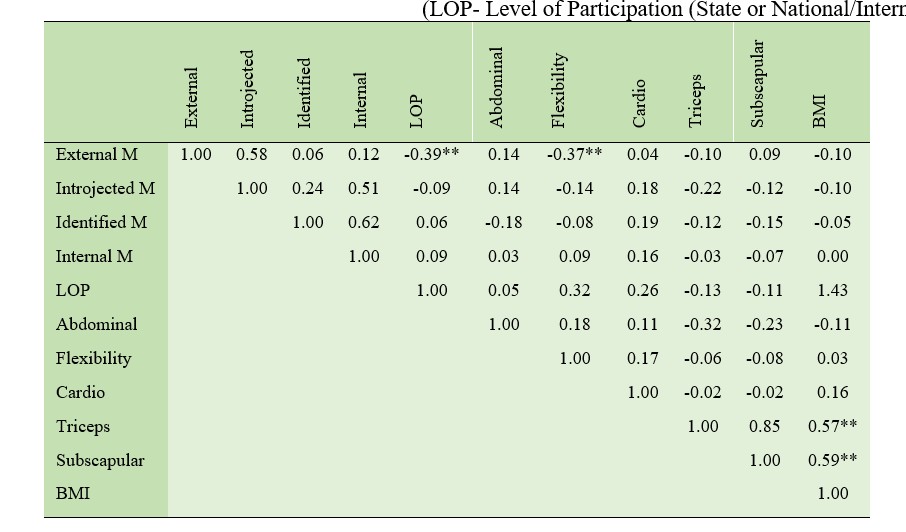Exercise Motivation of College Students in Relation to their Health-Related Physical Fitness
DOI:
https://doi.org/10.60081/SSHA.3.1(Spl).2025.460-464Keywords:
motivational styles, Flexibility, Health, FitnessAbstract
Based on Self termination Theory (SDT), this study aimed to examine the relationship betwe- en self-determination motivation for health-related fitness and perceived learning abilities am ong female college students in physical education. To assess even regulatory motivational styles, questionnaires were used to self-regulate training to measure four motivational styles: exogenous motivation, introduced motivation, identification, and essential motivation. Health-related fitness was assessed using the Aaphherd Test (1980). These tests werem conducted in 50 female sports students aged 17-25. Descriptive statistics and correlations were used to analyze the data. Results showed that exogenous motivational styles among students demonstrated a significant and negative relationship with flexibility (hips).
References
Biddle, S.J., & Nigg, C.R. (2000). Theories of exercise behaviour. International Journal of Sport Psychology, 31, 290-304.
Daley, A., & Duda, J. L. (2006). Self-determination, stage of readiness to change for exercise, and frequency of physical activity in young people. European Journal of Sport Science, 6, 231e243.
Deci, E. L., & Ryan, R. M. (1985). Intrinsic motivation and self-determination in human behavior. New York: Plenum.
Deci, E., & Ryan, R. (2000). The “what” and “why” of goal pursuits: Human needs and the self-determination of behavior. Psychological Inquiry, 11, 227–268.
Fox, K. R. (1997). The physical self: From motivation to well-being. Champaign, IL: Human Kinetics.
Grajek, M.; Sas-Nowosiel, K.; Sobczyk, K.; Dzialach, E.; Bialek-Dratwa, A.; Gorski, M.; Kobza, J. Motivation to engage in physical activity among heath sciences students. J. Phys. Educ. Sport 2021, 21, 140–144
Hassandra, M.,Goudas,M. and Chroni,S. (2003). Examining factors associated with intrinsic motivation in physical education: a qualitative approach. Psychology of Sport and Exercise. pp. 211–223.
Landry, J. B., & Solomon, M. A. (2004). African American women’s self determination across the stages of change for exercise. Journal of Sport & Exercise Psychology, 26, 457–469.
Markland, D., & Tobin, V. (2004). A modification of the Behavioral Regulation in Exercise Questionnaire to include an assessment of amotivation. Journal of Sport and Exercise Psychology, 26, 191-196.
Ntoumanis, N. (2001). A self-determination approach to the understanding of motivation in physical education. British Journal of Educational Psychology, 71, 225 – 242.
Pelletier, L. G., Fortier, M. S., Vallerand, R. J., & Brière, N. M. (2001). Associations among perceived autonomy support, forms of self-regulation, and persistence: A prospective study. Motivation & Emotion, 25, 279–306.
Reinboth, M., & Duda, J. L. (2006). Perceived motivational climate, need satisfaction, and indices of well-being in team sports: A longitudinal perspective. Psychology of Sport & Exercise, 7, 269–286.
Reinboth, M., Duda, J. L., & Ntoumanis, N. (2004). Dimensions of coaching behavior, need satisfaction, and the psychological and physical welfare of young athletes. Motivation & Emotion, 28, 297–313.
Ryan, R. M. (1995). Psychological needs and the facilitation of integrative processes. Journal of Personality, 63, 397-427.
Ryan, R. M., & Deci, E. L. (2000). Self-determination theory and the facilitation of intrinsic motivation, social development, and well-being. American Psychologist, 55, 68-78.
Ryan, R.M., & Connell, J.P. (1989). Perceived locus of causality and internalization: Examining reasons for acting in two domains. Journal of Personality and Social Psychology, 57, 749-761.
Sallis, J.F., & McKenzie, T.L. (1991). Physical education’s role in public health. Research Quarterly for Exercise and Sport, 62, 124± 137.Sarrazin, P., Vallerand, R. J., Guillet, E.,
Standage, M., Duda, J. L., & Ntoumanis, N. (2003). Predicting motivational regulations in physical education: The interplay between dispositional goal orientations, motivational climate and perceived competence. Journal of Sports Sciences, 21, 631 –647.
Sánchez-Herrera, S., Cubero, J., Feu, S., & Durán-Vinagre, M. Á. (2022). Motivation regarding physical exercise among health science university students. International journal of environmental research and public health, 19(11), 6524.
Pelletier, L. G., & Cury, F. (2002). Motivation and dropout in female handballers: A 21-month prospective study. European Journal of Social Psychology, 32, 395–418.
Vallerand, R. J. (2001). A hierarchical model of intrinsic and extrinsic motivation in sport and exercise. In G. C. Roberts (Ed.), Advances in motivation in sport and exercise (pp. 263–319). Champaign, IL: Human Kinetics.
Watson, D., Clark, L.A and Tellegen, A. (1988). Development and validation of brief measures of positive and negative affect. The PANAS scales. Journal of Personality and Social Psychology, 54 (6), 1063-1070.
Wilson, P. M., Rodgers, W. M., Fraser, S. N., & Murray, T. C. (2004). Relationships between exercise regulations and motivational consequences in university students. Research Quarterly for Exercise & Sport, 75, 81–91.

Downloads
Published
Issue
Section
License
Copyright (c) 2025 Sachin Yadav

This work is licensed under a Creative Commons Attribution 4.0 International License.







